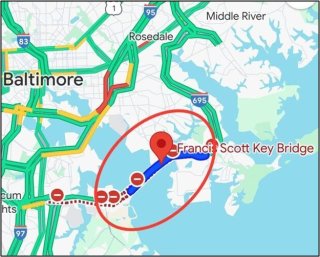Suspension of Vessel Traffic at Port of Baltimore: Current Status and Potential Impact on Supply Chain Disruptions
Last Updated: 05/28/2024
Archived Content: This content is not maintained and may no longer apply. For current information on supply chain disruptions, visit EPA's Current Supply Chain Disruptions.
Current Status

Early in the morning of March 26, 2024, a large cargo ship struck the Francis Scott Key Bridge in Baltimore, MD, causing the bridge to collapse into the Patapsco River. The bridge collapse is now blocking cargo ship traffic from accessing the Port of Baltimore.
The port is still processing trucks inside of its terminals, but it has suspended inbound and outbound vessel traffic until further notice. It is expected that the port will be out of commission indefinitely.
April 12 Update: The Port of Baltimore released a statement that includes: “The (U.S. Army Corps of Engineers) expects to open a channel 280-feet wide and 35-feet deep by the end of April and reopen the permanent 700-foot wide, 50-foot deep channel by the end of May.”
Relevant Links/Reports
Potential Impact on Water/Wastewater System Supply Chains
The Port of Baltimore offers the deepest harbor in Maryland’s Chesapeake Bay and is closer to the Midwest than any other East Coast port. However, it is one of the smallest container ports on the Northeastern seaboard, holding just 4% of all East Coast trade volume. It is the busiest U.S. port for imported vehicles, farm and construction machinery, and agricultural products (e.g., sugar, salt, gypsum, fertilizers, forest products). Other top imports include paper/paperboard and plywood/veneer/particle board.
Shipping will likely be rerouted to other U.S. ports. It is unclear how this will impact those ports and whether this situation will impact supply chains of chemicals or other critical products needed for water and wastewater treatment and operations.
April 16 Update: EPA has not received reports of supply chain disruptions resulting from the bridge collapse that are impacting water and wastewater systems. This section will be updated if there are further developments.
How to Prepare for Potential Supply Chain Disruptions
- Access EPA resources. Visit our Water and Wastewater Sector Supply Chain Resilience webpage to access resources your system can use to prepare for, or respond to, a potential supply chain disruption.
